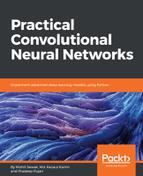In Chapter 2, Introduction to Convolutional Neural Networks, we discussed that a regular multilayer perceptron works fine for small images (for example, MNIST or CIFAR-10). However, it breaks down for larger images because of the huge number of parameters it requires. For example, a 100 × 100 image has 10,000 pixels, and if the first layer has just 1,000 neurons (which already severely restricts the amount of information transmitted to the next layer), this means 10 million connections; and that is just for the first layer.
CNNs solve this problem using partially connected layers. Because consecutive layers are only partially connected and because it heavily reuses its weights, a CNN has far fewer parameters than a fully connected DNN, which makes it much faster to train, reduces the risk of overfitting, and requires much less training data. Moreover, when a CNN has learned a kernel that can detect a particular feature, it can detect that feature anywhere on the image. In contrast, when a DNN learns a feature in one location, it can detect it only in that particular location.
Since images typically have very repetitive features, CNNs are able to generalize much better than DNNs for image processing tasks such as classification, using fewer training examples. Importantly, a DNN has no prior knowledge of how pixels are organized; it does not know that nearby pixels are close. A CNN's architecture embeds this prior knowledge. Lower layers typically identify features in small areas of the images, while higher layers combine the lower-level features into larger features. This works well with most natural images, giving CNNs a decisive head start compared to DNNs:

For example, in Figure 1, on the left, you can see a regular three-layer neural network. On the right, a ConvNet arranges its neurons in three dimensions (width, height, and depth) as visualized in one of the layers. Every layer of a ConvNet transforms the 3D input volume to a 3D output volume of neuron activations. The red input layer holds the image, so its width and height would be the dimensions of the image, and the depth would be three (red, green, and blue channels). Therefore, all the multilayer neural networks we looked at had layers composed of a long line of neurons, and we had to flatten input images or data to 1D before feeding them to the neural network.
However, what happens once you try to feed them a 2D image directly? The answer is that in CNNs, each layer is represented in 2D, which makes it easier to match neurons with their corresponding inputs. We will see examples of this in upcoming sections. Another important fact is that all the neurons in a feature map share the same parameters, so it dramatically reduces the number of parameters in the model; but more importantly, it means that once the CNN has learned to recognize a pattern in one location, it can recognize it in any other location.
In contrast, once a regular DNN has learned to recognize a pattern in one location, it can recognize it only in that particular location. In multilayer networks such as MLP or DBN, the outputs of all neurons of the input layer are connected to each neuron in the hidden layer, and then the output will again act as the input to the fully connected layer. In CNN networks, the connection scheme that defines the convolutional layer is significantly different. The convolutional layer is the main type of layer in a CNN, where each neuron is connected to a certain region of the input area called the receptive field.
In a typical CNN architecture, a few convolutional layers are connected in a cascade style. Each layer is followed by a Rectified Linear Unit (ReLU) layer, then a pooling layer, then one or more convolutional layers (+ReLU), then another pooling layer, and finally one or more fully connected layers. Pretty much depending on problem type, the network might be deep though. The output from each convolution layer is a set of objects called feature maps, generated by a single kernel filter. Then the feature maps can be used to define a new input to the next layer.
Each neuron in a CNN network produces an output, followed by an activation threshold, which is proportional to the input and not bound:

As you can see in Figure 2, the pooling layers are usually placed after the convolutional layers (for example, between two convolutional layers). A pooling layer into subregions then divides the convolutional region. Then, a single representative value is selected, using either a max-pooling or an average pooling technique, to reduce the computational time of subsequent layers. This way, a CNN can be thought of as a feature extractor. To understand this more clearly, refer to the following figure:

In this way, the robustness of the feature with respect to its spatial position is increased too. To be more specific, when feature maps are used as image properties and pass through the grayscale image, it gets smaller and smaller as it progresses through the network; but it also typically gets deeper and deeper, as more feature maps will be added.
We've already discussed the limitations of such FFNN - that is, a very high number of neurons would be necessary, even in a shallow architecture, due to the very large input sizes associated with images, where each pixel is a relevant variable. The convolution operation brings a solution to this problem as it reduces the number of free parameters, allowing the network to be deeper with fewer parameters.
